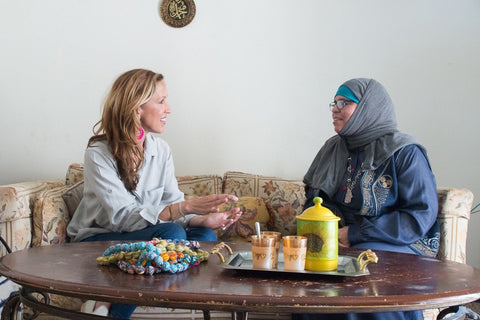What Is a Hijab? Why Do Women Wear Them?
At GAIA we are accustomed to seeing women in hijabs. Huda and Bothina wear hijabs when they come to work in our office, and several of our other refugee artisans cover their heads in public as well. We’re around women who wear head coverings all the time. But we realize that many Americans are not and that, in fact, the who and why and where of the hijab, also called a veil, simply isn’t well understood by most people in the United States. So we decided to shed a little light on the subject, with the help of a site called Arabs in America, directed and sponsored by the University of North Carolina-Chapel Hill.
The Who and Why
Though there are Christian women and Jewish women and also Arab men who wear headscarves, this story is about Muslim women.
It’s a common misunderstanding that Muslim women are forced to cover their heads, and though Taliban law imposed the burqa (a head-to-toe dress that covers every inch of a woman, including her eyes) on Pakistani and Afghani women, a hijab is not the same thing and the Taliban is no longer in power.

Most Muslim women will tell you that covering their heads is a choice — and that they are proud to do so. In fact, many say that a headscarf or even a face veil gives them freedom and protection. It’s all a matter of perspective!
There are a variety of reasons a woman might elect to wear a hijab. Most wear hijabs for religious reasons. Some believe that God has instructed them to do so and wear it as a symbol of devotion. Others, however, don’t perceive a head covering as obligatory but wear it instead to express their Islamic identity and show their faith. There are other women who cover their heads as an expression of cultural identity and a challenge to prejudice. Some women wear it sometimes and don’t wear it other times.
We asked Bothina how she feels about wearing her hijab, and she told us, "When I am walking and wearing my hijab in the street or wherever I am, it's as if I am expressing how proud I am of my faith and the human being I am." (We love this explanation — it kind of blew us away!)

The Where
Muslim women cover their heads anytime they are going to be around men who are not part of their immediate family (think: husbands, sons, brothers, fathers). They don’t wear hijabs when they are at home with only their families or when they are with only other women in someone’s home. Anytime they go out in public, they will cover their heads.
The How
All hijabs are hijabs but there are other kinds of hijabs. Does that sound confusing? Let us explain.
The word “hijab” is simply the Arabic word for “cover.” It is used both as a general term for modest attire that includes a headscarf and as a certain type of headscarf. A hijab can be worn tightly or loosely.

The most common type of hijab is called simply a hijab, and that’s what you’re most likely to encounter in the United States. It’s a square scarf that covers the head and neck but leaves the face free. This is what the Muslim women who work with GAIA wear.
The shayla is another type of hijab. It is a long, rectangular scarf that is wrapped loosely around the head and tucked or pinned at the shoulders. It covers the head but often leaves both the neck and face exposed.
The khimar is a long, cape-like scarf that covers the head, neck, and shoulders and hangs to the middle of the back. The face is left uncovered.

A floor-length version of the khimar is called the chador. Worn with a khimar or other headscarf, the niqab covers the mouth and nose but leaves the eyes clear. Though Latifa doesn’t wear a niqab in her daily life in the United States, when she goes to visit her family in Tunisia she does.
OK! That’s a lot, but we hope it has helped demystify head coverings. And if you have more questions, we encourage you to ask a Muslim woman about her hijab the next time you see one. There’s nothing like having a real conversation!
For answers to more questions about refugees, read Refugee Resettlement 101.


Comments on this post (0)